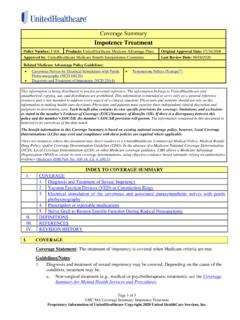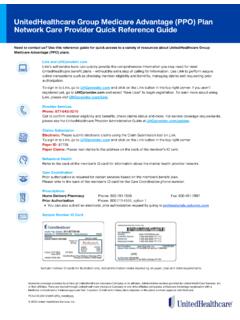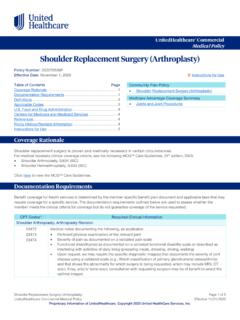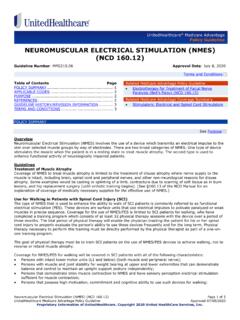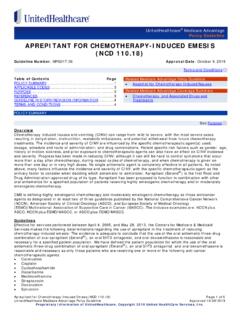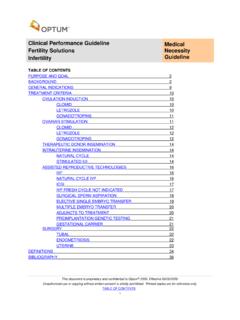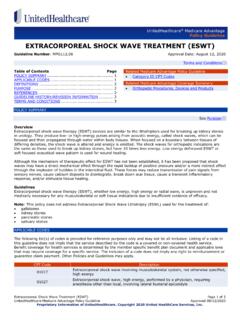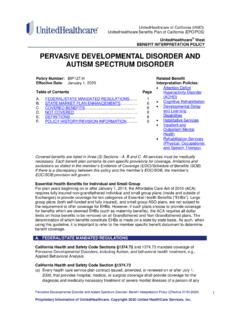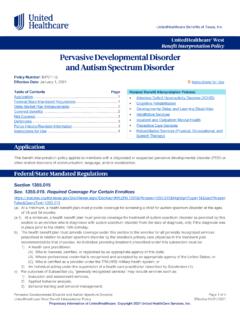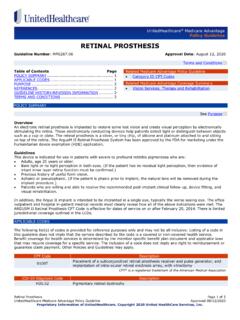Transcription of Percutaneous Transluminal Angioplasty (PTA) (NCD 20.7)
1 Percutaneous Transluminal Angioplasty (PTA) (NCD ) Page 1 of 10 UnitedHealthcare Medicare Advantage Policy Guideline Approved 02/10/2021 Proprietary Information of UnitedHealthcare. Copyright 2021 United HealthCare Services, Inc. UnitedHealthcare Medicare Advantage Policy Guideline Percutaneous Transluminal Angioplasty (PTA) (NCD ) Guideline Number: Approval Date: February 10, 2021 Terms and Conditions Table of Contents Page Policy Summary .. 1 Applicable Codes .. 3 References .. 8 Guideline History/Revision Information .. 9 Purpose .. 9 Terms and Conditions .. 9 Policy Summary See Purpose Overview This broad NCD addresses the treatment of various vessels, however, the focus for this policy is those that are performed for the following: Concurrent with Carotid Stent Placement in Food and Drug Administration (FDA)-Approved Category B Investigational Device Exemption (IDE) Clinical Trials.
2 Concurrent with Intracranial Stent Placement in FDA-Approved Category B IDE Clinical Trials. This procedure involves inserting a balloon catheter into a occluded or narrow blood vessel to recanalize and dilate the vessel by inflating the balloon . The objective of PTA is to improve the blood flow through the diseased segment of a vessel so that vessel patency is increased and embolization is decreased. With the development and use of balloon Angioplasty for treatment of atherosclerotic and other vascular stenoses, PTA (with and without the placement of a stent) is a widely used technique for dilating lesions of renal, peripheral, and coronary arteries. Guidelines Medicare covers PTA of the carotid artery concurrent with carotid stent placement when furnished in accordance with the FDA-approved protocols governing Category B IDE clinical trials.
3 PTA of the carotid artery, when provided solely for the purpose of carotid artery dilation concurrent with carotid stent placement, is considered to be a reasonable and necessary service when provided in the context of such a clinical trial. Medicare covers PTA and stenting of intracranial arteries for the treatment of cerebral artery stenosis 50% in patients with intracranial atherosclerotic disease when furnished in accordance with the FDA-approved protocols governing Category B IDE clinical trials. CMS determines that coverage of intracranial PTA and stenting is reasonable and necessary under these circumstances. Related Medicare Advantage Policy Guideline Category III CPT Codes Related Medicare Advantage Reimbursement Policy Global Days Policy, Professional Related Medicare Advantage Coverage Summaries Experimental Procedures and Items, Investigational Devices and Clinical Trials Percutaneous Transluminal Angioplasty and Stenting Percutaneous Transluminal Angioplasty (PTA) (NCD ) Page 2 of 10 UnitedHealthcare Medicare Advantage Policy Guideline Approved 02/10/2021 Proprietary Information of UnitedHealthcare.
4 Copyright 2021 United HealthCare Services, Inc. Other Guidelines Treatment of Atherosclerotic Obstructive Lesions In the lower extremities, , the iliac, femoral, and popliteal arteries, or in the upper extremities, , the innominate, subclavian, axillary, and brachial arteries. The upper extremities do not include head or neck vessels. Of a single coronary artery for patients for whom the likely alternative treatment is coronary bypass surgery and who exhibit the following characteristics: o Angina refractory to optimal medical management; o Objective evidence of myocardial ischemia; and o Lesions amenable to Angioplasty . Of the renal arteries for patients in whom there is an inadequate response to a thorough medical management of symptoms and for whom surgery is the likely alternative.
5 PTA for this group of patients is an alternative to surgery, not simply an addition to medical management. Of arteriovenous dialysis fistulas and grafts when performed through either a venous or arterial approach. Concurrent with Carotid Stent Placement in FDA-Approved Post Approval Studies Medicare covers PTA of the carotid artery concurrent with the placement of an FDA-approved carotid stent and an FDA-approved or -cleared embolic protection device for an FDA-approved indication when furnished in accordance with FDA-approved protocols governing post-approval studies. The Centers for Medicare & Medicaid Services (CMS) determines that coverage of PTA of the carotid artery is reasonable and necessary in these circumstances.
6 Concurrent with Carotid Stent Placement in Patients at High Risk for Carotid Endarterectomy (CEA) Medicare covers PTA of the carotid artery concurrent with the placement of an FDA-approved carotid stent with embolic protection for the following: Patients who are at high risk for CEA and who also have symptomatic carotid artery stenosis 70%. Coverage is limited to procedures performed using FDA-approved carotid artery stenting (CAS) systems and FDA-approved or -cleared embolic protection devices. If deployment of the embolic protection device is not technically possible, and not performed, then the procedure is not covered by Medicare; Patients who are at high risk for CEA and have symptomatic carotid artery stenosis between 50% and 70%, in accordance with the Category B IDE clinical trials regulation (42 CFR ), as a routine cost under the clinical trials policy (Medicare National Coverage Determination (NCD) Manual ), or in accordance with the NCD on (CAS) post-approval studies (Medicare NCD Manual ).
7 Patients who are at high risk for CEA and have asymptomatic carotid artery stenosis 80%, in accordance with the Category B IDE clinical trials regulation (42 CFR ), as a routine cost under the clinical trials policy (Medicare NCD Manual ), or in accordance with the NCD on CAS post- approval studies (Medicare NCD Manual ). Coverage is limited to procedures performed using an FDA-approved CAS, stents and FDA-approved or -cleared embolic protection devices. The use of an FDA-approved or cleared embolic protection device is required. If deployment of the embolic protection device is not technically possible, and not performed, then the procedure is not covered by Medicare. Patients at high risk for CEA are defined as having significant comorbidities and/or anatomic risk factors ( , recurrent stenosis and/or previous radical neck dissection), and would be poor candidates for CEA.
8 Significant comorbid conditions include but are not limited to: Congestive heart failure (CHF) class III/IV; Left ventricular ejection fraction (LVEF) < 30 %; Unstable angina; Contralateral carotid occlusion; Recent myocardial infarction (MI); Previous CEA with recurrent stenosis; Prior radiation treatment to the neck; and Percutaneous Transluminal Angioplasty (PTA) (NCD ) Page 3 of 10 UnitedHealthcare Medicare Advantage Policy Guideline Approved 02/10/2021 Proprietary Information of UnitedHealthcare. Copyright 2021 United HealthCare Services, Inc. Other conditions that were used to determine patients at high risk for CEA in the prior carotid artery stenting trials and studies, such as ARCHER, CABERNET, SAPPHIRE, BEACH, and MAVERIC II.
9 Symptoms of carotid artery stenosis include carotid transient ischemic attack (distinct focal neurological dysfunction persisting less than 24 hours), focal cerebral ischemia producing a nondisabling stroke (modified Rankin scale < 3 with symptoms for 24 hours or more), and transient monocular blindness (amaurosis fugax). Patients who have had a disabling stroke (modified Rankin scale 3) shall be excluded from coverage. The determination that a patient is at high risk for CEA and the patient s symptoms of carotid artery stenosis shall be available in the patient medical records prior to performing any procedure. The degree of carotid artery stenosis shall be measured by duplex Doppler ultrasound or carotid artery angiography and recorded in the patient's medical records.
10 If the stenosis is measured by ultrasound prior to the procedure, then the degree of stenosis must be confirmed by angiography at the start of the procedure. If the stenosis is determined to be <70% by angiography, then CAS should not proceed. In addition, CMS has determined that CAS with embolic protection is reasonable and necessary only if performed in facilities that have been determined to be competent in performing the evaluation, procedure and follow-up necessary to ensure optimal patient outcomes. Standards to determine competency include specific physician training standards, facility support requirements and data collection to evaluate outcomes during a required reevaluation. The CMS has created a list of minimum standards modeled in part on professional society statements on competency.
